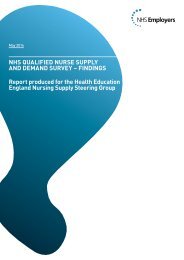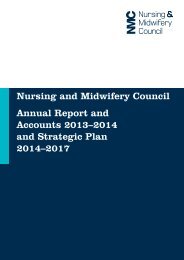Journal_1_2014_final_WEB
Journal_1_2014_final_WEB
Journal_1_2014_final_WEB
You also want an ePaper? Increase the reach of your titles
YUMPU automatically turns print PDFs into web optimized ePapers that Google loves.
Science, Practice and Education<br />
Any patient can develop a PU dependent on its individual<br />
comorbidity, the performed procedures and the intensity<br />
of nursing care. An American analysis on changes in the<br />
percentage of licensed nursing staff in Pennsylvanian hospitals<br />
between 1991 and 1997 led to the conclusion that<br />
almost all complications are seen more often in hospitals<br />
with fewer licensed nursing staff, in particular pressure ulcers<br />
and pneumonia 14 . A Swedish group who examined the<br />
problem of pressure ulcers in intensive care wards reported<br />
that 58 % of nursing staff think lack of time was a significant<br />
factor whenever pressure ulcer risk was not properly<br />
evaluated or aid devices were employed either inadequately<br />
or not at all 15 . For Germany, our analyses indicate that a<br />
low number of full-time employees in nursing homes had<br />
an influence on the incidence of pressure ulcers both as<br />
primary and as secondary diagnosis 16 .<br />
There is no predominant principal diagnosis which is<br />
associated with a relevant number of PUs. Older people<br />
having PU documented as an additional diagnosis in Germany<br />
in 2005 had femur fracture in 6.9 %, heart failure<br />
in 5.4 % and pneumonia in 5.2 % as the most frequent<br />
principal diagnosis 4 . It remains unclear if there is a specific<br />
risk associated with these diseases if it is just a selection of<br />
old and immobile patients. In contrast in those presenting<br />
with PU as the principal diagnosis the classical risk<br />
factors faecal and urinary incontinence seem to have a<br />
relevant impact either on the development of PU or on<br />
the admission to hospital. These patterns of comorbidity<br />
did not change in the period from 2005 to 2011 as we<br />
did not expect it to change 17,18 .<br />
Limitations<br />
Although routine data in the electronic patient record are<br />
frequently used for secondary purposes, there is currently<br />
no systematic analysis of coding quality in Germany 10 .<br />
Whether coding matches reality as a prerequisite for further<br />
use of the data in medicine and health politics has<br />
to be investigated in controlled trials. Thus, we cannot<br />
estimate the rate of wrong coding of the grades or the<br />
localizations of pressure ulcers.<br />
In conclusion, in Germany the rate of cases hospitalized<br />
with the principal diagnosis PU did not increase whereas<br />
the rate of PU documented in hospitalized patients increased<br />
from 2005 to 2011. Thus, PU is still a relevant<br />
problem. This analysis pointed out some specific aspects<br />
in PU localization and comorbidity that show the multidimensional<br />
dimension of the problem. <br />
m<br />
Acknowledgement<br />
We thank Referat VIII A 1 from the Federal Statistical Office<br />
for extracting and providing the data from the DRG-Statistik.<br />
References<br />
1. Amlung SR, Miller WL, Bosley LM. The 1999 National Pressure Ulcer Prevalence<br />
Survey: a benchmarking approach. Adv Skin Wound Care. 2001;14:297-301.<br />
2. Lahmann NA, Halfens RJ, Dassen T. Pressure ulcers in German nursing homes and<br />
acute care hospitals: prevalence, frequency, and ulcer characteristics. Ostomy<br />
Wound Manage. 2006;52:20-33<br />
3. Scott JR, Gibran NS, Engrav LH, Mack CD, Rivara FP. Incidence and Characteristics<br />
of Hospitalized Patients with Pressure Ulcers: State of Washington, 1987 to 2000.<br />
Plast. Reconstr. Surg.2006;117:630<br />
4. Kröger K, Niebel W, Maier I, Stausberg J, Gerber V, Schwarzkopf A. Prevalence of<br />
pressure ulcers in hospitalized patients in Germany in 2005: data from the Federal<br />
Statistical Office. Gerontology. 2009;55:281-7.<br />
5. Gunningberg L, Stotts NA, Idvall E. Hospital-acquired pressure ulcers in two Swedish<br />
County Councils: cross-sectional data as the foundation for future quality improvement.Int<br />
Wound J. 2011;8:465-73.<br />
6. Vangilder C, Macfarlane GD, Meyer S. Results of nine international pressure ulcer<br />
prevalence surveys: 1989 to 2005. Ostomy Wound Manage. 2008;54:40-54.<br />
7. Vandenkerkhof EG, Friedberg E, Harrison MB. Prevalence and Risk of Pressure<br />
Ulcers in Acute Care Following Implementation of Practice Guidelines: Annual<br />
Pressure Ulcer Prevalence Census 1994-2008. J Healthc Qual. 2011 Jan 11. doi:<br />
10.1111/j.1945-1474.2010.00127.x.<br />
8. Kottner J, Wilborn D, Dassen T, Lahmann N. The trend of pressure ulcer prevalence<br />
rates in German hospitals: results of seven cross-sectional studies. J Tissue Viability.<br />
2009;18:36-46.<br />
9. Mueller-Bergfort S, Fritze J. Diagnose- und Prozedurendaten im deutschen<br />
DRG-System. Bundesgesundheitsblatt Gesundheitsforschung Gesundheitsschutz<br />
2007;50:1047-1054<br />
10. Stausberg J. Quality of coding in acute inpatient care. Bundesgesundheitsblatt<br />
Gesundheitsforschung Gesundheitsschutz. 2007;50:1039-1046.<br />
11. Wilborn D, Grittner U, Dassen T, Kottner J. The National Expert Standard Pressure<br />
Ulcer Prevention in Nursing and pressure ulcer prevalence in German health care<br />
facilities: a multilevel analysis. J Clin Nurs 2010;19:3364-71.<br />
12. Groeneveld A, Anderson M, Allen S, Bressmer S, Golberg M, Magee B, Milner M,<br />
Young S. The prevalence of pressure ulcers in a tertiary care pediatric and adult<br />
hospital. J Wound Ostomy Continence Nurs. 2004;31:108-120<br />
13. Clegg A, Kring D, Plemmons J, Richbourg L. North Carolina wound nurses examine<br />
heel pressure ulcers. J Wound Ostomy Continence Nurs. 2009;36:635-9.<br />
14. Unruh L. Licensed nurse staffing and adverse events in hospitals. Med Care 2003;<br />
41:142-52<br />
15. Strand T, Lindgren M. Knowledge, attitudes and barriers towards prevention of<br />
pressure ulcers in intensive care units: a descriptive cross-sectional study. Intensive<br />
Crit Care Nurs 201026: 335-342<br />
16. Kröger K, Becker R, Weiland D, Lax H, Priebel J, Maier I. Regional differences in the<br />
incidence of inpatients with pressure ulcers in Germany. J Public Health 2012;<br />
10.1007/s10389-012-0504-0<br />
17. Arndt KA, Dohrendorf H, Tannen A, Braumann A, Dassen T. Prevalence of urinary<br />
incontinence in hospitals and nursing homes: an underestimated problem. Pflege Z.<br />
2006;59:635-638.<br />
18. Tabali M, Kollross CM, Braumann A, Tannen A, Dassen T. Fecal incontinence – an<br />
analysis of German clinics and nursing homes: breaking the taboo. Pflege Z.<br />
2006;59:639-642.<br />
14<br />
EWMA <strong>Journal</strong> <strong>2014</strong> vol 14 no 1




